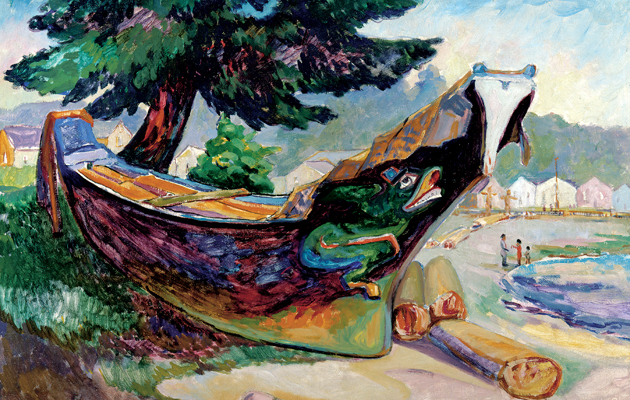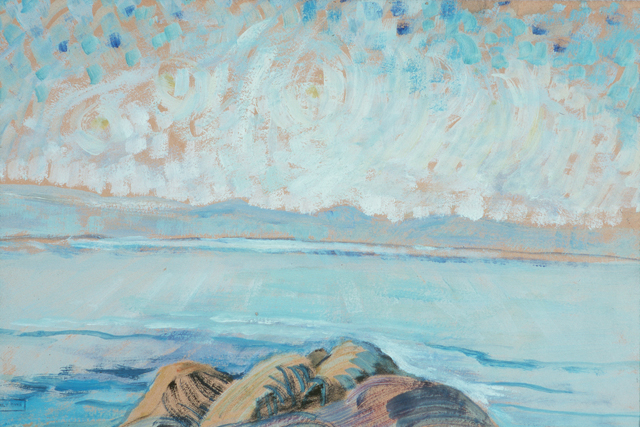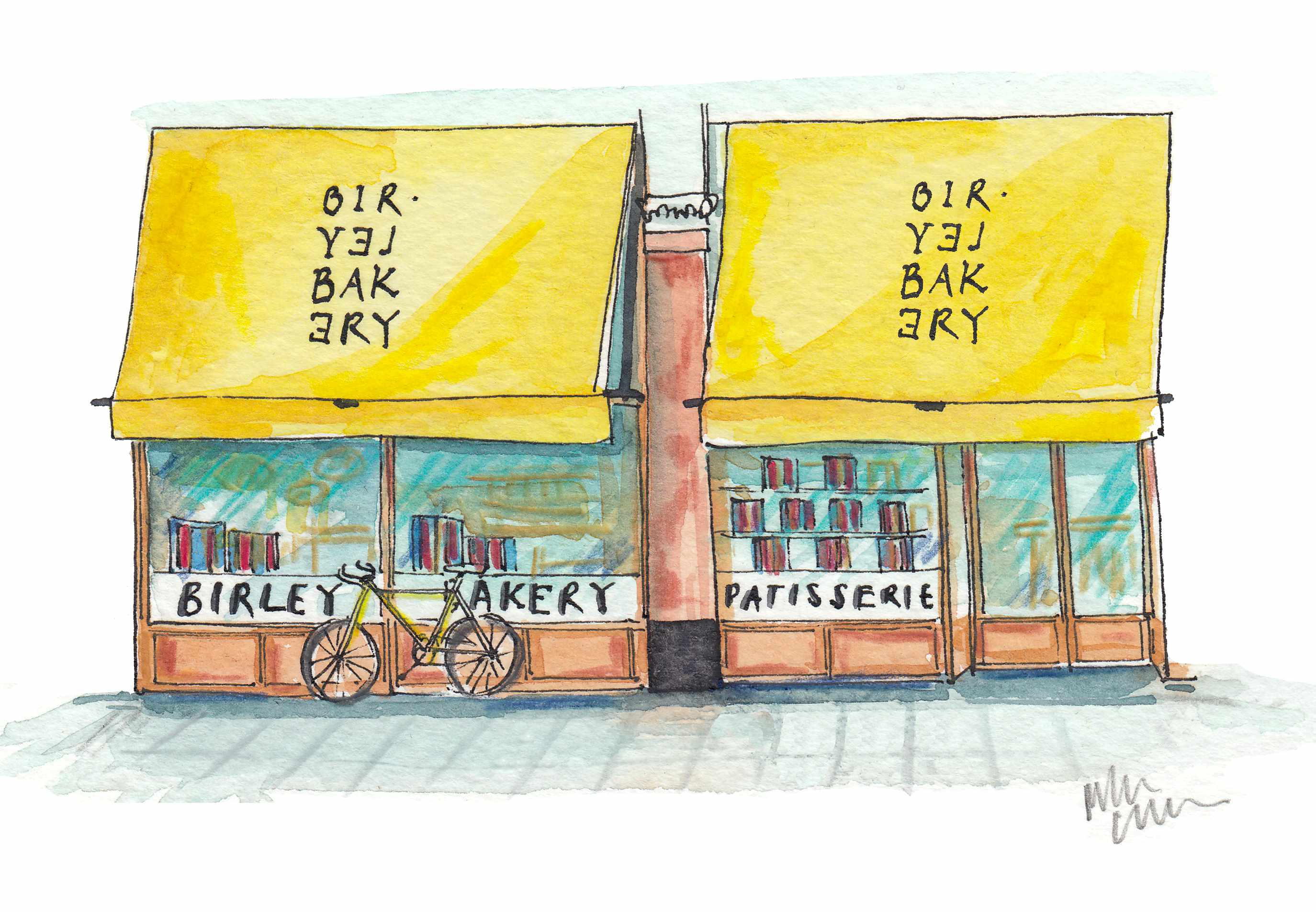Exhibition review: Emily Carr (1871-1945) at the Dulwich Picture Gallery
Dulwich Picture Gallery presents the first major solo exhibition in Europe of the Canadian artist Emily Carr, exhibiting six rooms of paintings, drawings, and journals as well as an array of indigenous artefacts from the Haida, Tsimshian and Kwakwaka’wakw tribes in British Columbia.


Emily Carr, Indian War Canoe (Alert Bay), 1912.
Born in Victoria, British Columbia in 1871, Emily Carr is one of Canada’s most cherished artists. Her depictions of an untouched subject - the remote, Westernmost parts of Canada - made her a national icon, but she was virtually unknown outside her country. Named by Georgia O’Keefe as ‘a darling of the woman’s movement,’ Carr’s enigmatic character played a huge part in her artistic career. Her defiant nature did not lend itself well to everyday city life. Having completed courses at both The San Francisco Art Institute and Westminster School of Art, her turbulent temperament led to an 18-month breakdown, spent in an English sanatorium. On her recovery in 1904, she returned to Canada and began teaching at the Vancouver Ladies Art Club. Here, she continued her struggle to identify with her own culture. Her somewhat unorthodox schooling methods and offensive behaviour led to many of her classes being boycotted: she swore at her students and continuously smoked in class and it soon became apparent that she was not a natural teacher.
In the first decade of the 20th century, Carr began to travel to First Nations villages and had her first encounters with the indigenous people of British Columbia that sparked her career as an artist. In one such village, Ucluelet, the locals nicknamed her ‘The laughing one’, in stark contrast to her students’ less fond memories. She had an appetite for documenting her experiences, both written and painted, and produced numerous journals; indeed, it was her writing that first attracted public recognition.

It was in 1907 that Carr made the most crucial trip of her career. With her sister Alice, she visited Alaska and was exposed to the fading traditions of Aboriginal monumental carving. She was hooked. It was here that she first came into contact with totem poles and made it her ambition to document the vestiges of this extraordinary dying culture. Epidemics of small pox and venereal disease meant that villages were being wiped out, and those left were battling new laws that effectively rendered many of their traditional practices illegal. After her first bite of the indigenous culture, Carr’s determination grew. Battling seasickness, brutal weather conditions and mosquitos, she journeyed to remote areas and across rough terrain to reach the isolated lands and villages that were to become the subject of her work. She became comfortable with the tribespeople and, while remaining a solitary figure, was no longer an outsider.
In one watercolour, Skedans Poles (In Rain), the paint slides along the canvas to evoke the lashing of rain. Upon closer inspection, we see the physical, hundred year old raindrops spattering the surface and imagine Carr, canvas nailed to a tree trunk, battling it out against the elements. These efforts demonstrate her empathy with the tribes and their culture.
Carr’s painting style is so dynamic you can almost hear the whispering of leaves. She is at her most sensual in her forestry subjects. These scenes of wild, inner-woodland life show where she spent much of her time. She would sit beneath the branches for hours, feeling the trees’ ‘protecting spread, their uplifting rise, their solid immoveable strength.’ ‘Everything is waiting and still, slowly things begin to move, to slip into their places’, she recalled. The trees have personalities of their own. Nature’s rhythms pulsate through her brushstrokes. The forest nurtured the ground that she sat on and protected her from the unforgiving weather. The cedar trees were particularly important to native life because they could withstand moisture. The cedar bark was vital for weaving clothes, while its wood was used for totem poles, as well as for canoes and housing.
Far from being a passive commentator, Carr expressed her concern about capitalism’s effect on her beloved British Columbia. In the final room is the oil painting Scorned as Timber, Beloved of the Sky (1935). It reveals the abrupt reality of deforestation. One lone tree reaches for the sky with intense spirituality, just as the totem poles had done. The singular tree is the only redemptive, living force in this desolate landscape. It somehow reminds us of Carr’s own living force in such an unfamiliar and remote environment, reaching out to protect a tradition.
Sign up for the Country Life Newsletter
Exquisite houses, the beauty of Nature, and how to get the most from your life, straight to your inbox.
Rather than making her out of touch with artistic changes, Carr’s nomadic lifestyle heavily influenced her style and made her aware of the artistic movements of Fauvism, Post-Impressionism and Cubism. The most pronounced example of this can be seen in the final room, where two paintings show the same scene: traditional Indian war canoes pulled up onto the beach at Alert Bay. The first is a proficient and tidy Victorian watercolour in subdued tones. The second, painted five years later, is a vibrant coloured essay in the Fauvist style. In this vivid re-creation of the scene, we get a sense of Carr’s newfound ease and confidence with her palette.
It comes as a surprise to learn that Carr sold hardly any of her work during her lifetime. In fact, she virtually ceased painting between 1913 to 1927, running an unsuccessful boarding house instead, to try to make ends meet. Only in 1927 did she begin to be recognised, when the National Gallery of Canada selected some of her works for a show on Canadian west-coast art.
From the Forest to the Sea: Emily Carr in British Columbia is at Dulwich Picture Gallery, London until 8th March 2015. www.dulwichpicturegallery.org.uk
Country Life is unlike any other magazine: the only glossy weekly on the newsstand and the only magazine that has been guest-edited by HRH The King not once, but twice. It is a celebration of modern rural life and all its diverse joys and pleasures — that was first published in Queen Victoria's Diamond Jubilee year. Our eclectic mixture of witty and informative content — from the most up-to-date property news and commentary and a coveted glimpse inside some of the UK's best houses and gardens, to gardening, the arts and interior design, written by experts in their field — still cannot be found in print or online, anywhere else.
-
 'That’s the real recipe for creating emotion': Birley Bakery's Vincent Zanardi's consuming passions
'That’s the real recipe for creating emotion': Birley Bakery's Vincent Zanardi's consuming passionsVincent Zanardi reveals the present from his grandfather that he'd never sell and his most memorable meal.
By Rosie Paterson
-
 The Business Class product that spawned a generation of knock-offs: What it’s like to fly in Qatar Airways’ Qsuite cabin
The Business Class product that spawned a generation of knock-offs: What it’s like to fly in Qatar Airways’ Qsuite cabinQatar Airways’ Qsuite cabin has been setting the standard for Business Class travel since it was introduced in 2017.
By Rosie Paterson